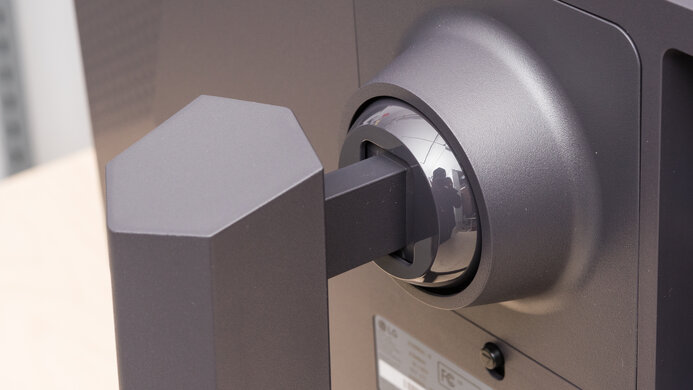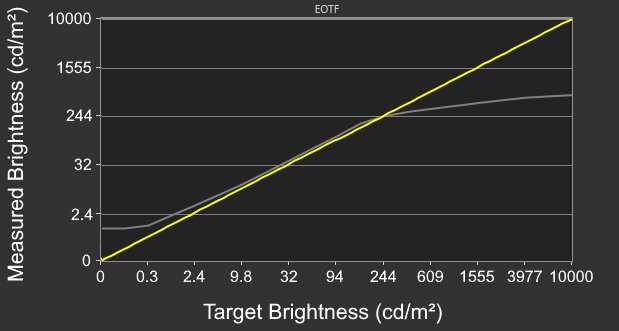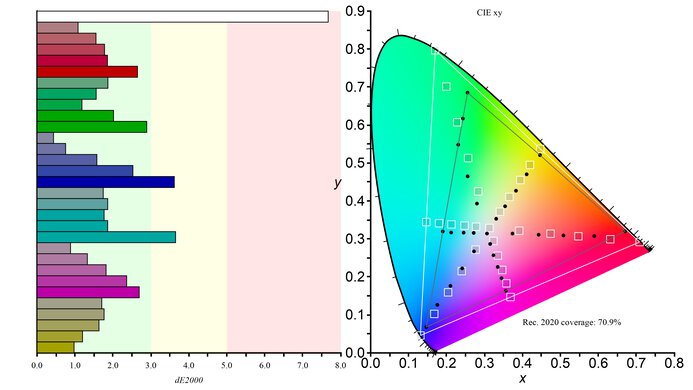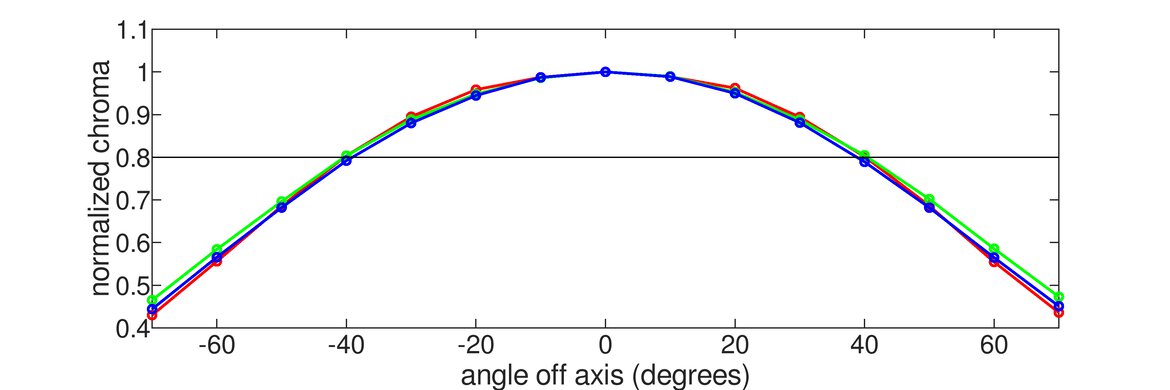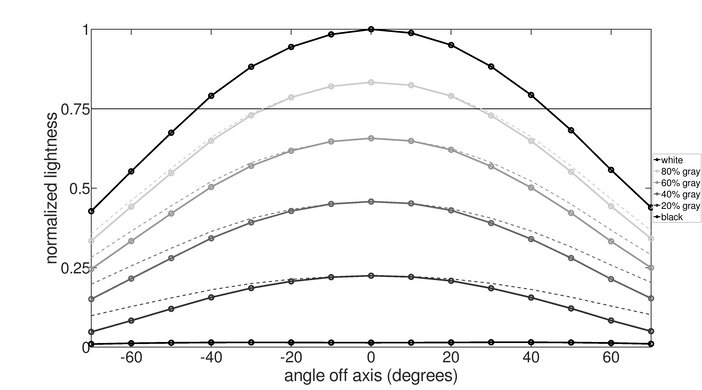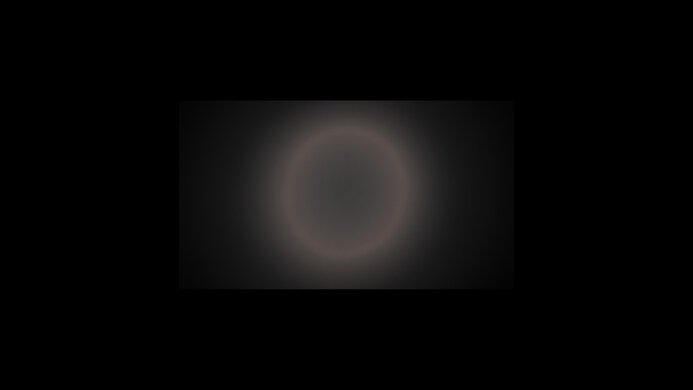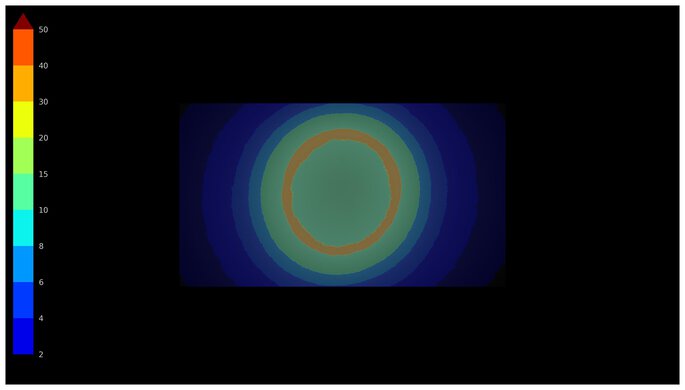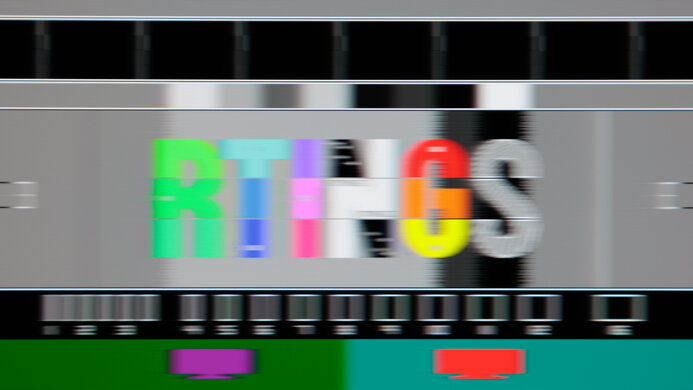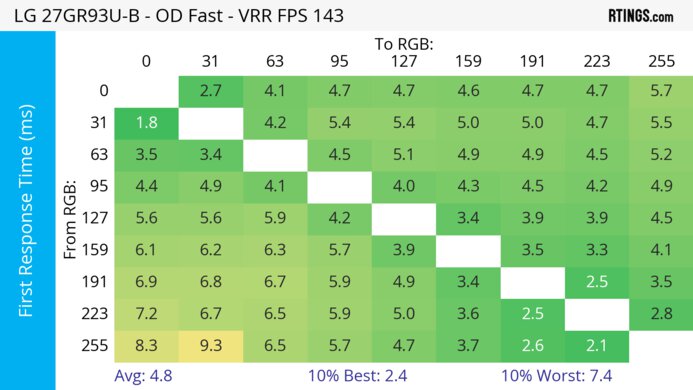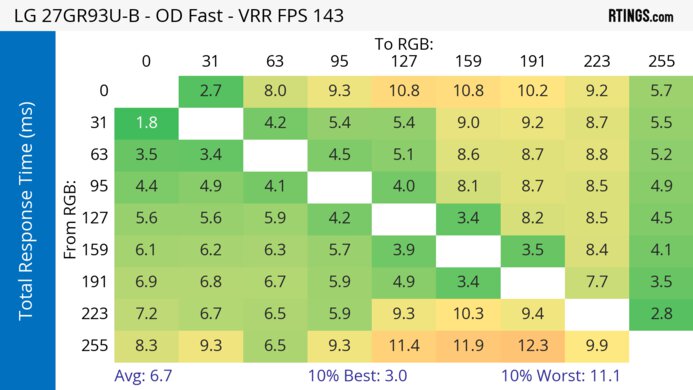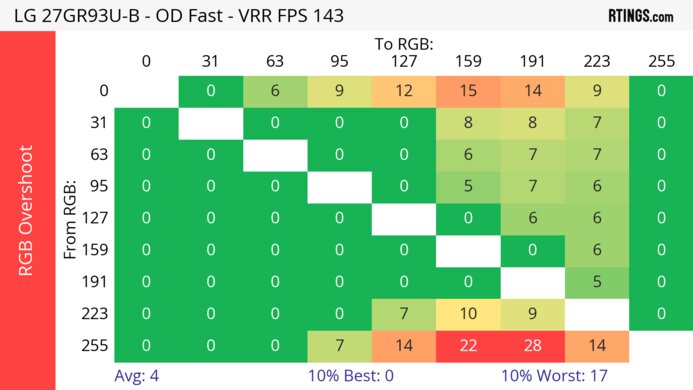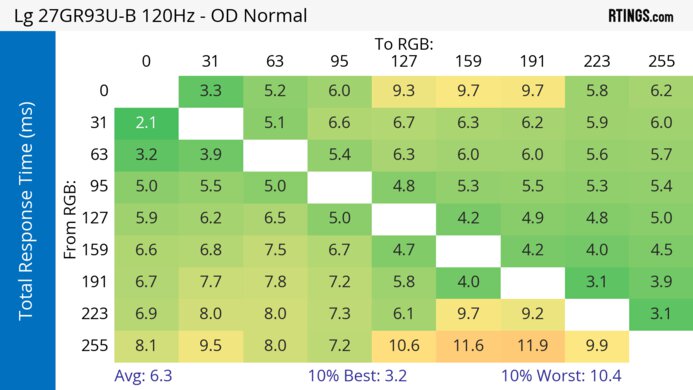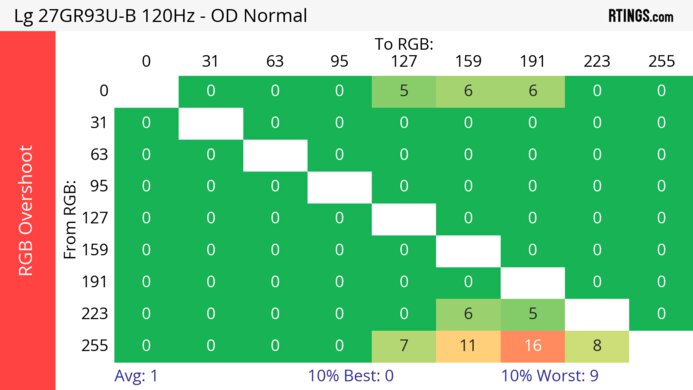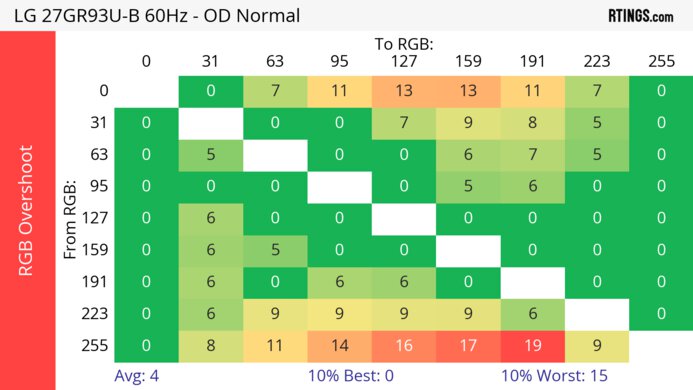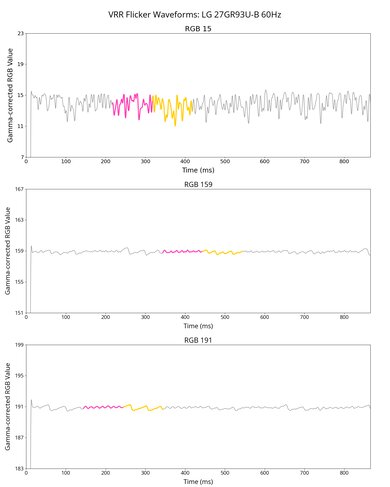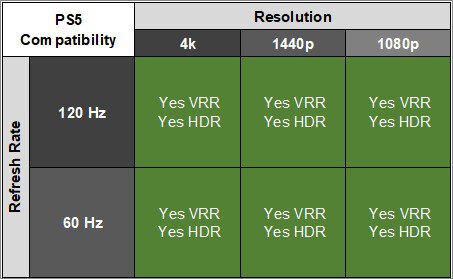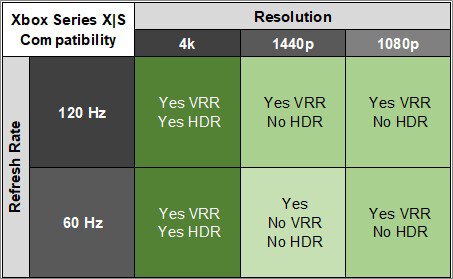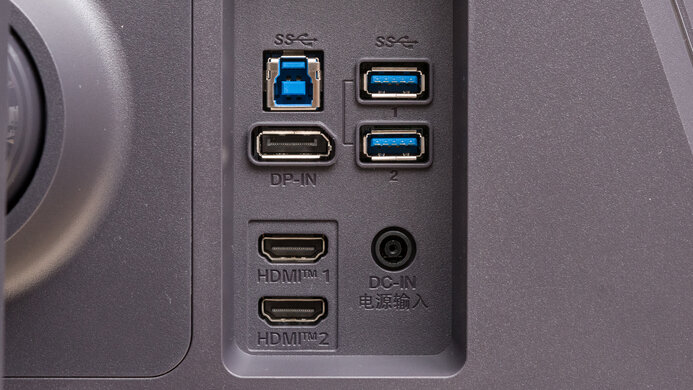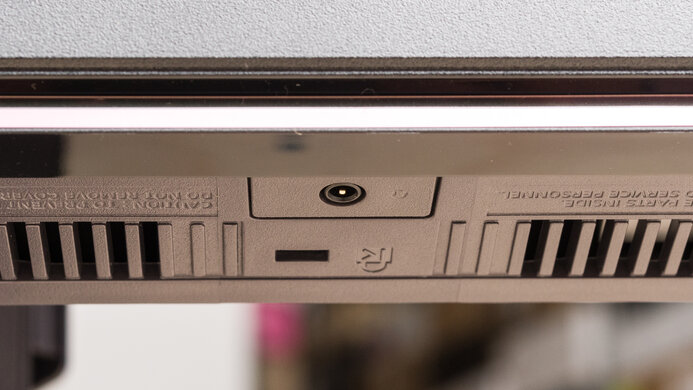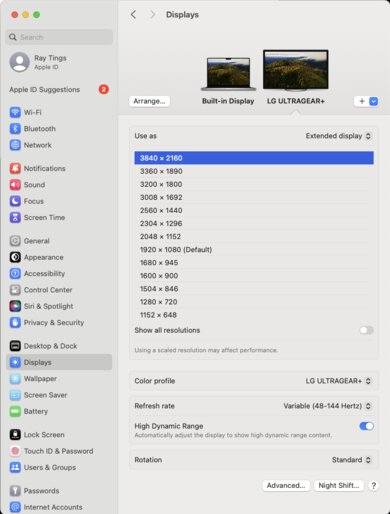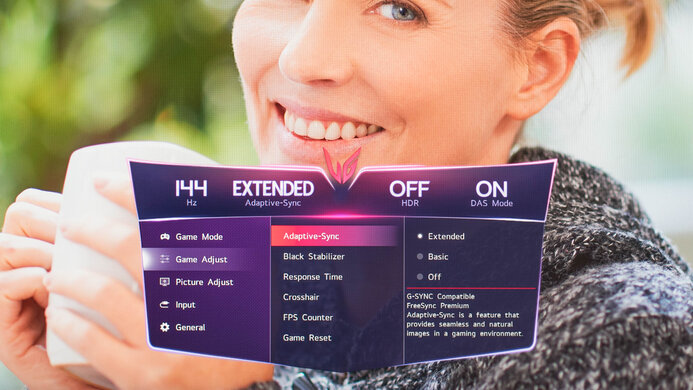The LG 27GR93U-B is a mid-range gaming monitor. It's one of two 4k, 144Hz monitors in LG's 2023 lineup, with a smaller screen than the LG 32GR93U-B. It's also a lower-end model than the older LG 27GP950-B, which has a higher refresh rate. It has features you'd expect to find in a gaming monitor, like FreeSync variable refresh rate (VRR) support and G-SYNC compatibility. It also supports HDMI 2.1 bandwidth, allowing you to take full advantage of gaming consoles and modern graphics cards. Other than that, it's rather barebones in terms of features, but its audio port supports DTS Headphone:X audio, so you can listen to high-quality audio with compatible headphones.
Our Verdict
The LG 27GR93U-B is decent for PC gaming. Some competitive gamers may find its 144Hz refresh rate limiting, but it supports HDMI 2.1 bandwidth and all common VRR formats to reduce screen tearing. Luckily, it has low input lag for a responsive feel and it has a fast response time for sharp motion at high refresh rates, but there's more blur at 60Hz. Unfortunately, it has a low contrast ratio that makes blacks look gray, so it isn't ideal for dark room gaming as it has limited picture quality.
- 144Hz refresh rate and VRR support.
- Fast response time at high refresh rates.
- Low input lag.
- Blacks look gray in the dark.
- Limited HDR brightness.
- More motion blur at 60Hz.
The LG 27GR93U-B is great for console gaming. It takes full advantage of the Xbox Series X|S and PS5 thanks to its HDMI 2.1 bandwidth, and it delivers detailed images thanks to its HDMI 2.1 bandwidth. Gaming feels responsive due to its low input lag, and it has a fast response time at 120Hz for sharp motion, but there's more blur at 60Hz. Sadly, it's a disappointing choice if you want realistic images, as it has limited picture quality due to its low contrast and lack of local dimming.
- HDMI 2.1 bandwidth.
- Fast response time at high refresh rates.
- Low input lag.
- Blacks look gray in the dark.
- Limited HDR brightness.
- More motion blur at 60Hz.
The LG 27GR93U-B is impressive for office use. It has a 4k resolution that results in high pixel density on its 27-inch screen, so it has fantastic text clarity because of this. You won't have many issues using it in a well-lit room either, as it gets very bright, but has mediocre reflection handling. It even has wide viewing angles that help when you need to share your screen with someone else, but it lacks swivel adjustment to easily turn the screen. Unfortunately, it lacks many extra productivity features, as it only has two USB ports.
- 4k resolution for sharp text and images.
- Bright enough to fight glare.
- Wide viewing angles.
- No swivel adjustment.
- Only has two USB-A ports.
Mediocre reflection handling.
The LG 27GR93U-B is good for media creation. It has impressive accuracy before calibration in its sRGB mode, and it also displays a wide range of colors. It has a high 4k resolution that helps deliver sharp images, and it performs well in bright rooms thanks to its high peak brightness. It has wide viewing angles that are useful if you often need to share your screen with a coworker or client, but it doesn't have a swivel adjustment to easily turn the screen.
- 4k resolution for sharp text and images.
- Bright enough to fight glare.
- Wide viewing angles.
- Impressive accuracy in the sRGB mode.
- No swivel adjustment.
- Only has two USB-A ports.
- Blacks look gray in the dark.
The LG 27GR93U-B has good brightness. It easily gets bright enough to fight intense glare in well-lit rooms, but it doesn't make small highlights pop in HDR.
- Bright enough to fight glare.
- Limited HDR brightness.
The LG 27GR93U-B has a good overall response time. It performs best close to its max refresh rate as fast-moving objects look sharp, but there's more blur at lower refresh rates.
- Fast response time at high refresh rates.
- More motion blur at 60Hz.
The LG 27GR93U-B is terrible for HDR. It has a low contrast ratio that makes blacks look gray, and it lacks a local dimming feature to further improve the picture quality. It also struggles to make colors look vivid and highlights pop.
- Blacks look gray in the dark.
- No local dimming feature.
The LG 27GR93U-B has decent picture quality in SDR. While it displays a wide range of colors, it has limited picture quality due to its low contrast that makes blacks look gray.
- Displays wide range of colors.
- Blacks look gray in the dark.
The LG 27GR93U-B has excellent color accuracy. Calibrating it results in the most accurate image, but it still has impressive accuracy before calibration in its sRGB mode. It also has good gray uniformity that keeps the image consistent throughout most of the screen, but the edges are darker.
- Impressive accuracy in the sRGB mode.
- Good gray uniformity.
Performance Usages
Changelog
- Updated Nov 10, 2025: We've converted this review to Test Bench 2.1.1. We removed the Vertical Viewing Angle test.
-
Updated Jul 24, 2025:
We updated text throughout to match the new and updated tests with Test Bench 2.1, including in the Verdict section.
- Updated Jul 21, 2025: We've converted this review to Test Bench 2.1. This includes new tests for Direct Reflections, Ambient Black Level Raise, and Total Reflected Light. You can see all the changes in the changelog.
-
Updated Mar 31, 2025:
We added that the AOC AGON PRO AG276QZD2 has a higher max refresh rate.
Check Price
Differences Between Sizes And Variants
We tested the 27-inch LG 27GR93U, and the results are only valid for this review. While there's the 32-inch LG 32GR93U-B also available, it's a separate monitor.
| Model | Size | Panel Type | Resolution | Max Refresh Rate |
|---|---|---|---|---|
| 27GR93U-B | 27" | IPS | 4k | 144Hz |
Our unit was manufactured in June 2023; you can see the label here.
Popular Monitor Comparisons
The LG 27GR93U-B is a good all-around 4k monitor that offers HDMI 2.1 bandwidth, VRR support, and a 144Hz refresh rate, so it's great for console gaming, but it isn't as ideal for competitive PC gaming. It also has limited picture quality due to its low contrast and lack of local dimming. While it has slightly worse motion handling than the larger LG 32GR93U-B, it's a good alternative if you want something cheaper and smaller. That said, it isn't as versatile as the Gigabyte M27U for other uses like work, so that monitor is the better choice if you want something for better value that costs less and has extra features.
See our recommendations for the best 4k gaming monitors, the best 4k 144Hz monitors, and the best 32-inch monitors.
The LG 27GR93U-B and the Gigabyte M27U are both 4k gaming monitors. They have many similar features, especially for gaming, but the LG supports higher HDMI bandwidth, so it doesn't need to use compression for demanding signals like on the Gigabyte. That said, the Gigabyte has a few extra features for productivity, like a USB-C port and KVM switch, making it the better choice for multitasking with different devices.
The LG 27GP950-B is a higher-end monitor than the LG 27GR93U-B, so it has a few extra features, but they perform similarly otherwise. They each have a native 144Hz refresh rate, but the 27GP950-B has an overclock feature to go up to 160Hz. That said, the motion handling is similar between each. The 27GP950-B also has a local dimming feature, which the 27GR93U-B doesn't have, and it allows it to get brighter in HDR, but the local dimming feature is terrible overall. On the other hand, the 27GR93U-B gets brighter, making it the better choice for use in well-lit rooms.
The LG 32GR93U-B and the LG 27GR93U-B are similar mid-range monitors, with one of the main differences being their sizes. There are still some differences in performance, though, as the 32-inch model has better motion handling, and it also has better HDR color volume for more vivid colors. Another difference is that the 27-inch model has improved brightness.
The Samsung Odyssey G7/G70B S32BG70 and the LG 27GR93U-B are both excellent 4k, 144Hz gaming monitors. The Samsung has an advantage with motion handling as it has a faster response time at lower refresh rates, but the LG has lower input lag at 60Hz. The Samsung has a bigger 32-inch screen, but that means it has lower pixel density and slightly worse pixel density. Besides that, the LG gets brighter, so it's the better choice for use in well-lit rooms.

We buy and test more than 30 monitors each year, with units that we buy completely on our own, without any cherry-picked units or samples. We put a lot into each unbiased, straight-to-the-point review, and there's a whole process from purchasing to publishing, involving multiple teams and people. We do more than just use the monitor for a week; we use specialized and custom tools to measure various aspects with objective data-based results. We also consider multiple factors before making any recommendations, including the monitor's cost, its performance against the competition, and whether or not it's easy to find.
Test Results

The LG 27GR93U-B has a rather simple design with a dark gray body. The back features a honeycomb pattern, and it has some RGB lighting that you can change with presets. Unfortunately, there's a silver reflective strip underneath the bottom bezel, which can be distracting if you have a bright light source in your room.
The build quality is good. There aren't any obvious quality control issues, but the bottom bezel isn't perfectly flush with the screen. That said, it isn't an issue unless you care about perfect aesthetics. The plastic materials are solid, and while the screen wobbles a bit on the stand, it stabilizes quickly.
The ergonomics are good, but without swivel adjustment, you can't easily turn it to show the screen to someone next to you. You can only rotate into portrait mode in a clockwise direction, which means the inputs are always on top. The stand also has a clip for cable management.
This monitor doesn't have a local dimming feature. Although it has a Variable Backlight setting, it only boosts the contrast level in HDR and doesn't turn off any dimming zones. We still film these videos on the monitor so that you can compare the backlight performance with a monitor that has local dimming.
The SDR brightness is impressive. It easily gets bright enough to fight glare, and it maintains its brightness consistently across different content. That said, its minimum brightness is high, which is disappointing if you want to use it in a dark room and you're sensitive to bright lights. These results are from after calibration in the 'Gamer 1' Game Mode with the Brightness at its max.
The LG UltraGear 27GR93U-B has decent HDR brightness. While it gets bright, small highlights don't pop against the rest of the image because it lacks a local dimming feature. It struggles with EOTF tracking as dark scenes are overbrightened, and it has an early roll-off, so highlights don't get very bright. These results are in the 'Gamer 1' Game Mode with the Brightness at its max.
If you want an LG monitor that gets even brighter in HDR, then look into the LG 27GR95UM-B.
The LG UltraGear 27GR93U-B has impressive accuracy before calibration in the sRGB mode. The white balance and most colors are only slightly inaccurate, but some primary colors are slightly oversaturated. The color temperature is a bit on the cold side, and gamma is higher than the target sRGB curve, so most content is slightly darker than intended. Unfortunately, the 'sRGB' Game Mode locks many settings, including Response Time, so if you want to use any of those settings, you'd have to use another picture mode that has more oversaturated colors, as you can see here.
The accuracy after calibration is fantastic. There are minimal inaccuracies, and you can use any of the settings that were locked out in the sRGB mode.
The SDR color gamut is incredible. It has perfect coverage of the common sRGB color space, and it also has excellent coverage of the Adobe RGB color space used in publishing. However, it oversaturates most colors in that color space, except cyans and blues, which are undersaturated.
The HDR color gamut is amazing. It has remarkable coverage of the DCI-P3 color space, but it struggles with tone mapping as most colors are off. The coverage in the wider Rec. 2020 color space is decent, but once again, it has some problems with tone mapping, as most colors are undersaturated.
The LG UltraGear 27GR93U-B has a decent HDR color volume. However, because it has limited HDR peak brightness and a low contrast ratio, it can't display very bright and dark colors well.
The horizontal viewing angle is good. It's a great choice if you need to share your screen with someone sitting next to you, as they'll see a consistent image from the sides.
The text clarity is fantastic. Its high pixel density helps result in sharp text, and enabling Windows ClearType (top photo) improves the clarity. These photos are in Windows 10, and you can see them in Windows 11 with ClearType on and with ClearType off.
The direct reflection handling is okay. The matte coating spreads light out, but it still has some mirror-like reflections.
The black levels remain consistent in a bright room, but they still look gray due to the monitor's low native contrast ratio.
To reach the monitor's max refresh rate over DisplayPort, your graphics card needs to support Display Stream Compression (DSC), which any NVIDIA 16 Series or AMD RX 5000 Series and newer graphics card supports. You can change the Input Compatibility Version setting if you want to disable DSC, though. If you're looking for a monitor with a higher refresh rate, check out the 240Hz AOC AGON PRO AG276QZD2.
| NVIDIA | VRR Min | VRR Max |
| DisplayPort | <20Hz | 144Hz |
| HDMI | <20Hz | 144Hz |
| AMD | VRR Min | VRR Max |
| DisplayPort | <20Hz | 144Hz |
| HDMI | <20Hz | 144Hz |
Besides supporting FreeSync and G-SYNC compatibility, the monitor also supports HDMI Forum VRR.
| Refresh Rate | CAD Heatmap | RT Chart | Pursuit Photo |
| 143 | Heatmap | Chart | Photo |
| 120 | Heatmap | Chart | Photo |
| 100 | Heatmap | Chart | Photo |
| 80 | Heatmap | Chart | Photo |
| 60 | Heatmap | Chart | Photo |
The LG 27GR93U-B has good motion handling across its entire refresh rate range with VRR enabled. Although the 'Fast' overdrive setting performs best at its max refresh rate, the 'Normal' setting is the most consistent as the refresh rate drops, with good CAD and not too much motion blur. The 'Faster' overdrive setting performs so badly that it passes the limits of the graph, as you can see here.
The refresh rate compliance is good. Although its response time struggles to keep up with its max refresh rate, this is typical of most LCD monitors, and it gets better with lower frame rates.
| Overdrive Mode | CAD Heatmap | RT Chart | Pursuit Photo |
| Off | Heatmap | Chart | Photo |
| Normal | Heatmap | Chart | Photo |
| Fast | Heatmap | Chart | Photo |
| Faster | Heatmap | Chart | Photo |
The CAD at the max refresh rate is very good. Even though the 'Fast' overdrive setting has a bit more overshoot than 'Normal', it's still within an acceptable an amount and has lower CAD, whereas the 'Faster' overdrive setting has too much overshoot.
| Overdrive Mode | CAD Heatmap | RT Chart | Pursuit Photo |
| Off | Heatmap | Chart | Photo |
| Normal | Heatmap | Chart | Photo |
| Fast | Heatmap | Chart | Photo |
| Faster | Heatmap | Chart | Photo |
The CAD at 120Hz is very good. Unlike at its max refresh rate, the 'Normal' overdrive setting has the lowest CAD, which means you may have to change the setting if the frame rate of your game drops or you change games. 'Fast' actually has the same CAD, but there's more overshoot causing inverse ghosting.
| Overdrive Mode | CAD Heatmap | RT Chart | Pursuit Photo |
| Off | Heatmap | Chart | Photo |
| Normal | Heatmap | Chart | Photo |
| Fast | Heatmap | Chart | Photo |
| Faster | Heatmap | Chart | Photo |
The CAD at 60Hz is decent. Although the recommended overdrive setting of 'Normal' has the lowest CAD, it has some inverse ghosting, so if that bothers you, it's better to use the 'Off' setting, which has a similar CAD and has the fastest total response time.
This monitor has no optional backlight strobing feature to reduce persistence blur.
The LG 27GR93U has low input lag for a responsive feel while gaming.
This monitor works well with the Xbox Series X|S, but you need to enable the HDMI override setting on the console for 1440p @ 60Hz to work, which also disables VRR. Keep in mind that the Xbox doesn't support HDR with 1080p or 1440p signals, so this isn't an issue with the monitor.
The 3.5mm audio output serves as a combo jack with audio out and mic in, but you need to have the USB-B cable connected to your computer to fully use it. It also comes with DTS Headphone:X to simulate surround sound audio.
If you want a monitor that delivers 65W of power over USB-C, check out the MSI MAG 274UPF.
The LG 27GR93U works well with macOS. Although it defaults to a 1080p resolution, you just need to change it to a 4k resolution. With a USB-C to DisplayPort cable, there's a bug with VRR where there's a grey bar that appears on top, which causes VRR to stop working. You need to exit the full-screen mode and go back in for it to work properly again. Over HDMI with an HDMI 2.1 MacBook, the max refresh rate is 144Hz without VRR, but it's limited to a max of 120Hz with VRR. If you're using a MacBook with either type of connection, windows return to their original position when reopening the lid or waking it up from sleep.
The LG 27GR93U has a few extra features, including:
- Black Stabilizer: Adjusts the gamma so that it's easier to see opponents in dark areas.
- Crosshair: Adds a virtual crosshair that your game's anti-cheat tool won't detect, giving you a competitive advantage.
- DFC: Changes the contrast based on the content.
- DTS Headphone:X: The monitor offers a few different sound modes to use with compatible devices.
- Hexagon Lighting: This is the setting to adjust the RGB lighting on the back of the monitor.
- Variable Backlight: Boosts the contrast level in HDR, but it isn't a local dimming setting.



